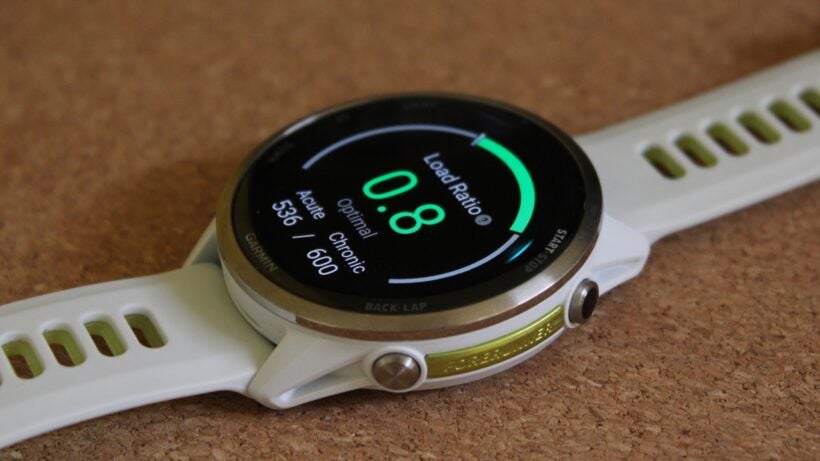Everything you need to know about Acute Load's helpful twin.
Your Garmin watch is full of useful metrics to help track your activities, and ‘Chronic Load’ can be an invaluable tool to help you ramp up your intensity sensibly.
The insight lives alongside ‘Acute Load’ within Connect and specific Garmin devices, and it essentially beefs up this area with more information to help you manage your condition.
Chronic Load has now been around for a couple of years. However, when it first launched, we got the inside track from Garmin about what it does and how to get the most out of it.
Whether you’re concerned about sustaining injuries as you up your training load, or you’re worried about the cumulative effect of some time off, Chronic Load is one you’ll soon be checking in on regularly after digesting our guide below.
SQUIRREL_PLAYLIST_10207701
What is Garmin’s Chronic Load?

Unlike Acute Load, which is a measure of the short-term cumulative sum of your training, Chronic Load instead broadens the scope and focuses on a longer period.
A Garmin spokesperson told Wareable: “We have been recording chronic load for some time, as it is used to highlight the green optimal range of acute load.”
According to Firstbeat, the Garmin analytics arm behind the metric, Chronic Load takes into account the last 28 days of training. Acute Load, meanwhile, only focuses on the last seven days.
It’s still represented as an overall figure in the same way Acute Load is, though, and can be tracked similarly through the Garmin Connect graph. It all means you’ll still receive an indication of whether your load has changed too quickly, and whether that figure is in a healthy range.
As shown above, this is also applied to your historical data (though, at least in our case, certain four-week ranges don’t have the option to apply Chronic Load).
Which devices support Chronic Load
- Garmin Forerunner series (including 165/265/570/955/965/970)
- Garmin Fenix series (7/7 Pro/E/8)
- Garmin MARQ Gen 2 series
- Garmin Epix series
How is Chronic Load calculated?
As it does with Acute Load, Firstbeat and Garmin use TRIMP to quantify each session and present you with an overall short-term figure.
TRIMP largely measures load through heart rate, though the length of a session is also taken into account.
Nothing changes when it comes to Chronic Load, except that the seven-day TRIMP calculation is expanded to include four weeks instead of just one.
How to use Garmin’s Chronic Load and Load Ratio

While Acute Load is relatively easy to understand, with clear indicators of when it’s ‘Low’, ‘Optimal’, ‘High’, or ‘Very High’, and its impact on your overall Training Status, Chronic Load is represented simply as a graph in Garmin Connect.
That means you’ll have to consult the Load Ratio shown on your Garmin device in order to analyze the relationship between your Acute Load and Chronic Load.
As explained by Firstbeat, referencing a study on injury prevention, the ideal situation for this relationship occurs when your Acute and Chronic loads are nearly equal (and the ratio is 1.0). Therefore, using the examples above, the left-hand value of 1.2 resides in a healthy zone, as both Acute and Chronic loads are well managed.
The right-hand value of 3.5, however, where a user has increased their Acute Load despite having a relatively low Chronic Load figure, is at a much higher risk of injury.
Firstbeat explains that the risk of injury begins at around 1.5 (something similar to the middle example shown above) and increases further as the separation between Acute and Chronic widens.
The simplest way to interpret this relationship is to view the graph in Garmin Connect and observe how the two figures align. The closer those numbers are to each other, the better.
In theory, you should also be able to increase your Acute Load by a relative value of 0.3 without significantly risking injury.
Find Chronic Load in Garmin Connect
After checking several Garmin devices, Chronic Load doesn’t appear to be available to view on the watch itself. However, it is available in Garmin Connect.
All you need to do is head to My Day > Training Status > Load > Acute Load > Chronic Load.
After selecting that Chronic Load tab, the graph will overlay orange boxes each day to indicate where your load sits against your Acute Load.




